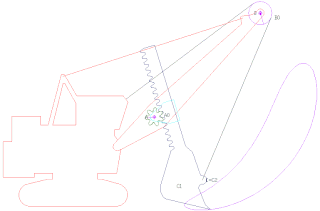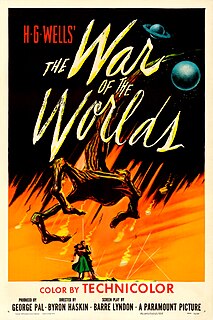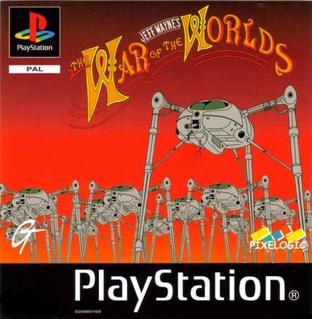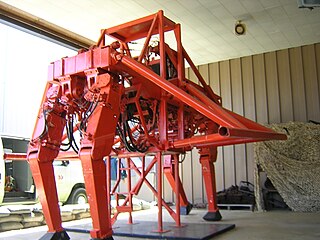In other adaptations
The embankment machine has been featured in the graphic novel by Dark Horse Comics. The machine here is portrayed as a mechanical earthworm that feeds the soil into a mouth-like intake rather than actually digging, and moves about on several mechanical feet like a centipede. Several of these are seen at the main Martian camp in London, left abandoned as the Martians succumb to the Earth's bacteria.
Another version appears in the 1998 PC Game based on Jeff Wayne's adaption. This digging mechanism was a bulky, four-legged machine whose purpose was to build defensive fortifications and related structures. Unlike the novel's version though, this machine does not seem to be automated.
No form of this autonomous alien machine has appeared in any film adaptations, but in War of the Worlds 2: The Next Wave , a sequel to The Asylum's 2005 low-budget film H. G. Wells' War of the Worlds , the Tripods, known as squid-walkers, are not controlled from the inside, but move at their own will. However, these machines are described as cybernetic life forms, not autonomous machines.

A Martian is an inhabitant of the planet Mars or a human colonist on Mars. Although the search for evidence of life on Mars continues, many science fiction writers have imagined what extraterrestrial life on Mars might be like.

Jeff Wayne's Musical Version of The War of the Worlds is the debut album by Jeff Wayne, retelling the story of The War of the Worlds by H. G. Wells. It was released in the UK on 9 June 1978. A concept album and a rock opera, its main format is progressive rock and string orchestra, using narration and leitmotifs to carry the story and rhyming melodic lyrics that express the feelings of the various characters. The two-disc album remains a bestseller, having sold 15 million copies worldwide. In 2018, it was named the 32nd best-selling studio album of all time in the UK. It has spawned multiple versions including video games, DVDs, and live tours.

Excavators are heavy construction equipment consisting of a boom, dipper, bucket and cab on a rotating platform known as the "house". The house sits atop an undercarriage with tracks or wheels. They are a natural progression from the steam shovels and often mistakenly called power shovels. All movement and functions of a hydraulic excavator are accomplished through the use of hydraulic fluid, with hydraulic cylinders and hydraulic motors. Due to the linear actuation of hydraulic cylinders, their mode of operation is fundamentally different from cable-operated excavators which use winches and steel ropes to accomplish the movements.

Martian Through Georgia is a 1962 Warner Bros. Looney Tunes cartoon, directed by Chuck Jones, Maurice Noble, and Abe Levitow. The short was released on December 29, 1962.

A steam shovel is a large steam-powered excavating machine designed for lifting and moving material such as rock and soil. It is the earliest type of power shovel or excavator. Steam shovels played a major role in public works in the 19th and early 20th century, being key to the construction of railroads and the Panama Canal. The development of simpler, cheaper diesel-powered shovels caused steam shovels to fall out of favor in the 1930s.

The fighting machine is one of the fictional machines used by the Martians in H.G. Wells' 1898 classic science fiction novel The War of the Worlds. It is a fast-moving, three-legged walker, reported to be 100 feet tall, with multiple whip-like tentacles used for grasping, and two lethal weapons: the Heat-Ray and a gun-like tube used for discharging canisters of a poisonous chemical black smoke that kills humans and animals. It is the primary machine the Martians use when they invade Earth, along with the handling machine, the flying machine, and the embankment machine.
The Handling machine is one of the fictional machines used by the Martians in H. G. Wells' 1898 science fiction novel The War of the Worlds. It is a crawling device used by the Martians to lift and manipulate other objects. It is one of the four types of heavy machine the Martians bring with them when they invade Earth, along with the fighting machine, the flying machine, and the embankment machine.
The Flying machine is one of the fictional machines used by the Martians in H. G. Wells' classic 1898 science fiction novel The War of the Worlds. It is one of the four types of heavy machine the Martians bring with them when they invade Earth, along with the fighting machine, the handling machine, and the embankment machine.

A bucket-wheel excavator (BWE) is a large heavy equipment machine used in surface mining.

The First Men in the Moon is a scientific romance by the English author H. G. Wells, originally serialised in The Strand Magazine from December 1900 to August 1901 and published in hardcover in 1901, who called it one of his "fantastic stories". The novel tells the story of a journey to the Moon undertaken by the two protagonists: a businessman narrator, Mr. Bedford; and an eccentric scientist, Mr. Cavor. Bedford and Cavor discover that the Moon is inhabited by a sophisticated extraterrestrial civilisation of insect-like creatures they call "Selenites".

The Martians, also known as the Invaders, are the fictional race of extraterrestrials from the H.G. Wells 1898 novel The War of the Worlds. They are the main antagonists of the novel, and their efforts to exterminate the populace of the Earth and claim the planet for themselves drive the plot and present challenges for the novel's human characters. They are notable for their use of extraterrestrial weaponry far in advance of that of mankind at the time of the invasion.

"The Crystal Egg" is a science fiction short story written by H. G. Wells in 1897.

A power shovel is a bucket-equipped machine, usually electrically powered, used for digging and loading earth or fragmented rock and for mineral extraction. Power shovels are a type of rope/cable excavator, where the digging arm is controlled and powered by winches and steel ropes, rather than hydraulics like in the more common hydraulic excavators. Basic parts of a power shovel include the track system, cabin, cables, rack, stick, boom foot-pin, saddle block, boom, boom point sheaves and bucket. The size of bucket varies from 0.73 to 53 cubic meters.
"Mars: The Home Front" is a short story by American writer George Alec Effinger, published in the 1996 anthology War of the Worlds: Global Dispatches. It is a crossover between H. G. Wells' 1898 novel The War of the Worlds and Edgar Rice Burroughs' Barsoom series.

The War of the Worlds is a 1953 American science fiction film from Paramount Pictures, produced by George Pal, directed by Byron Haskin, and starring Gene Barry and Ann Robinson.

The War of the Worlds is a science fiction novel by English author H. G. Wells, first serialised in 1897 by Pearson's Magazine in the UK and by Cosmopolitan magazine in the US. The novel's first appearance in hardcover was in 1898 from publisher William Heinemann of London. Written between 1895 and 1897, it is one of the earliest stories to detail a conflict between mankind and an extra-terrestrial race. The novel is the first-person narrative of both an unnamed protagonist in Surrey and of his younger brother in London as southern England is invaded by Martians. The novel is one of the most commented-on works in the science fiction canon.

Jeff Wayne's The War of the Worlds is a vehicular combat third-person shooter video game. It was based primarily on the 1978 concept album Jeff Wayne's Musical Version of The War of the Worlds, but also draws from the original 1898 War of the Worlds novel by H. G. Wells. The game was developed by Pixelogic and released in Europe exclusively for the Sony PlayStation in 1999. The game was never released in North America.

The Massacre of Mankind (2017) is a science fiction novel by British writer Stephen Baxter, an official sequel to H. G. Wells' 1898 classic The War of the Worlds, authorised by the Wells estate. It is set in 1920, 13 years after the events of the original novel, as a second Martian invasion is chronicled by Miss Elphinstone, the ex-sister-in-law of the narrator of War of the Worlds. Baxter also wrote an authorised sequel to Wells' novel The Time Machine, The Time Ships.

A walking vehicle is a vehicle that moves on legs rather than wheels or tracks. Walking vehicles have been constructed with anywhere from one to more than eight legs. There are many designs for the leg mechanisms of walking machines that provide foot trajectories with different properties.















